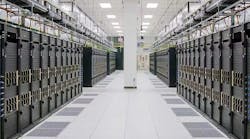Last January we identified eight themes that we believed would shape the data center business in 2020. How did we do? Let’s take a look, ranking whether each prediction was a Hit, Miss or Too Early.
First and foremost, we didn’t see foresee the year’s biggest story, the COVID-19 pandemic. It was an event that overshadowed all other trends and disrupted the world in ways we could have hardly imagined, serving up a fresh reminder that would-be futurists should proceed with humility. That said, the pandemic wound up reinforcing and accelerating many trends that were on our radar screen at the start of 2020. Here’s a look at our scorecard.
What’s ahead for 2021? Watch for our annual “Eight Trends” forecast on Wednesday, Jan. 6. You can also receive updates so you don’t miss our analysis.
1. The Data Tonnage Challenge Gets Real
PREDICTION: In 2020 the explosive growth of data will be felt like never before. We believe this is a sign of things to come, as next-generation technologies transform how we store, manage and move data. The data center will drive this disruption, and be shaped by it. Data tonnage creates challenges in both the distribution and concentration of data … The answer is two-fold: Bigger and faster networks, along with distributed compute capacity to perform “data thinning” before sending business-critical datasets across the network.
HIT: Data volume and movement were indeed felt as never before, as the pandemic drove a 30 percent increase in global network data traffic. Social distancing policies created a surge in remote work and media consumption, dramatically boosting the use of many online services, including streaming media, virtual private networks (VPNs), online gaming, cloud computing applications, telehealth applications and more. As for the concentration of data, this was clearly seen in the growth in Northern Virginia, the largest cloud capacity market, as well as hyperscale destinations like Phoenix.
2. The AI Arms Race Alters the Compute Equation
PREDICTION: Artificial intelligence (AI) can make products and services smarter. Every business yearns for that, which is why AI is emerging as a strategic priority. That’s driving a hardware arms race, featuring more innovation than the chip sector has seen in years. Intel says AI is creating an “insatiable “demand for faster, more power-efficient computing hardware. It will be a busy year for Intel, and fellow incumbents NVIDIA and AMD.
HIT: The chip sector looks very different than it did a year ago, and the compute equation has indeed been altered by powerful new chips. Domain-specific architectures have come to the fore, amid execution challenges for Intel, the dominant player in general purpose CPUs.
In 2020 the competitive landscape was transformed by several huge acquisitions. NVIDIA is buying ARM in a $40 billion deal that brings together the leaders in GPUs and low-power mobile chips, and a resurgent AMD announced plans to buy FPGA specialist Xilinx for about $35 billion. Meanwhile, startups like Ampere, Cerebras and SambaNova rolled chips into production. Although Intel is grappling with delays in key server chips, the company is building upon opportunities in networking and 5G telco.
3. On-Site Power Generation and Climate Risk
PREDICTION: Climate change is creating new challenges for the cost and availability of power. The data center industry will have to reckon with this trend in coming years, and we’re already seeing its impact. … As the impact of climate change on the bottom line becomes more visible …. on-site power generation will become more important.
HIT: Local energy infrastructure was in the news throughout 2020, including Microsoft’s sustainability-linked initiative to eliminate diesel fuel and an experiment with hydrogen fuel cells to support data center loads. Switch and Google each laid out plans to adopt utility-scale energy storage into their operations. Switch announced a massive adoption of Tesla Megapack batteries to support its Gigawatt 1 solar arrays, while Google said it would begin replacing generators with large lithium-ion batteries.
The West Coast wildfires in the summer of 2020 reinforced the risks to energy security we highlighted in January. “Data center operators, who have spent years working to improve energy efficiency and renewable power to head off climate damage, must now adapt to the real-time challenges of a changed environment,” DCF noted in a September update. “The predictably of utility power is being tested by the wildfires, which are forcing extraordinary power conservation efforts in California, including emergency shutoffs.”
4. Infrastructure Funds Target Green Power
PREDICTION: Wave power. Carbon capture. Solar and wind power at scale. These may all play a larger role in how data centers are powered in the future, as infrastructure funds bring new resources to deploying IT capacity at scale. That capability, along with a growing mandate for corporations to shift to greener energy footprint, lays the groundwork for new approaches to data center power.
TOO EARLY: For much of the year, the prospect of data center projects combining on-site renewables felt like it might be a complete Miss. But in late 2020 we saw a series of announcements of new campuses with a renewable energy component. These included:
- Echelon Data Centers announced a new 100 megawatt data center project in Arklow (Dublin market) that includes a direct supply of wind energy from SSE Renewables, which is building Ireland’s first offshore wind turbine installation.
- Terrascale announced plans for Energos Reno, a 20-megawatt data center project designed to tap multiple renewable energy sources (including solar and geothermal energy).
- Birch Infrastructure established a joint venture with Quinbrook Infrastructure Partners to develop multiple renewable-powered hyperscale data center campuses in the U.S. Birch has previously helped Iron Mountain provision renewable power for its data centers.
These are all new players and future projects, so it is Too Early to say that this trend moved the needle in 2020. But you can expect to see sustainability and renewable power be key narratives in 2021, and infrastructure funds will play a large role.
5. Data Center Districts Take Shape
PREDICTION: Data center districts will emerge in major markets, driven by both market forces and public policy. As data tonnage reinforces the importance of proximity, we’ll see more “knock-down” expansion projects, as developers buy adjacent properties and demolish existing buildings to create new data center campuses. In major cloud corridors, economics will make data centers the most valuable use for real estate.
MISS: There are a growing number of places where data center valuations are shifting real estate markets toward “knock-down economics.” But there wasn’t the kind of movement toward focused economic development districts that I had anticipated. Places like Mesa in the Phoenix market showcase the potential for this strategy, and there are a number of regions that have district strategies in the works. But most local economic development agencies spent 2020 managing the devastating impact of COVID-19 restrictions on business communities.
Data center districts provide an efficient focal point for infrastructure, and we can expect to see more of them. But 2020 was a time to focus on more urgent local challenges.
6. Cloud, Cloud, Cloud and Connectivity
PREDICTION: You no longer need a crystal ball to predict that enterprise cloud will continue to reshape the IT landscape. But if you need a reminder, here it is: The ongoing IT migration from on-premises data centers to colo and cloud providers is a multi-year transition. It’s a huge business, and is still gaining momentum. We’ll see a continuation of the rational reallocation of enterprise IT resources continue across cloud platforms, colocation facilities and on-premises data centers in 2020.
HIT: Sure, this was a layup, as predictions go. But the pace of demand and development in 2020 hit new scale in major markets. Hyperscale operators invested $100 billion in CapEx for their data centers in the first three quarters of 2020, a year in which customers leased more than 500 megawatts of power. The pandemic not only boosted capacity for distributed work and education, but also accelerated the digital transformation plans for many enterprise customers. With many companies conserving cash, much more of this enterprise cloud shift will be seen in 2021.
7. Edge Focus Shifts to Economics, Decoupling 5G Hype
PREDICTION: The economics of edge computing will come into sharp relief in 2020. End users and investors will focus on near-term cost/benefit analyses rather than long-term potential. Edge computing is a trend that will play out over many years, and has been boosted by enthusiasm over technologies with long deployment horizons. This timeline will be the backstory behind many of the headlines in edge computing this year. We believe there will be successes and disappointments alike in 2020, and both the “edge boom” and “edge hype” scenarios will drive an active M&A landscape.
HIT: It’s still early days in the lengthy edge rollout, but there are now real projects backed by real investment and with real customers. In September we noted the Business Edge had arrived in the form of “a flurry of announcements that showcased the many ways stakeholders in distributed computing are stepping up their investment and deploying real-world edge infrastructure. After many months of studying the market, companies are coming off the sidelines and deciding how they want to deploy infrastructure, and with whom.”
The “active M&A landscape” emerged quickly with the Equinix acquisition of Packet, followed by the sale of DartPoints and modular data center specialist Baselayer Technologies. In the year’s biggest edge-focused transaction, DataBank bought the zColo portfolio of regional data centers to advance its edge strategy. On the partnership front, Vapor IO teamed with Digital Realty on edge projects, and Switch announced an intriguing edge initiative with FedEx and Dell.
And yes, some players began to cut their losses, most notably Ericsson, which began informing partners that its Edge Gravity initiative “will shut down over time” after it failed to meet the company’s expectations.
8. Remote Management and Unstaffed Data Centers
PREDICTION: There are more servers than people to manage them. This challenge has been addressed primarily through automation, which has enabled a single sysadmin to manage tens of thousands of servers. The server-to-admin ratio is becoming problematic. As server growth continues to accelerate, staff development is not keeping pace. A “grey tsunami” of retirements may arrive amid strong growth for edge computing, which will mean data centers in more locations.
HIT: This prediction proved entirely accurate. But I certainly didn’t anticipate that the driving force would be a wild card – a global pandemic that placed extraordinary focus on staffing, employee health, and how to architect data center infrastructure so it can be operated with a bare-bones staffing. The COVID-19 pandemic has dramatically focused the industry’s ongoing focus on automation, adding concerns about employee health atop the already difficult math of data center staffing. Much more to come on this trend.
The Scorecard
It’s important to be accountable for your predictions and projections. At Data Center Frontier we will continue to track our annual forecasts, and report back to our readers about how they turn out. So here’s a look at our recent performance, and the final score for 2020.
2018 Scorecard: We had five Hits, one Miss and two predictions that qualify as “Too Early.”
2019 Scorecard: Six Hits, one Miss and one “Too Early” score.
2020 Scorecard: Once again, the final tally was six Hits, one Miss and one “Too Early.” Given what 2020 was like, we’ll take it.
Watch for our “Eight Trends That Will Shape the Data Center in 2021″ forecast on Wednesday, Jan. 6. You can also receive updates so you don’t miss our analysis.
Want to stay on top of these trends? Follow us on Twitter and Facebook, connect with me on LinkedIn, and sign up for our weekly newspaper using the form below:






